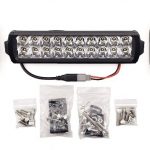
Trees, shrubs, and plants can be used in combination to create a living screen around your home.
(Courtesy: Dave Catchpole at flickr.com)
A drive through of many suburban neighborhoods in the United States reveals an easy flow from property to property. The majority of homeowners in a neighborhood do not put up barriers between their property and the properties of their neighbors. Still, there are reasons why a homeowner would want to put up a barrier. For example, they don’t want neighborhood dogs or kids trampling on their garden and lawn, there is something visible that a homeowner wishes to block from view, or the owner just believes that a fence made of a nice material or a living screen –- trees, shrubs and plants –- help to enhance the appearance and value of their property.
There are large assortments of fences made of all sorts of materials that can be painted that appear great and seem to frame a home. However, your only option doesn’t have to be solid hard and lifeless materials. Your “fence” or barrier can actually be a living screen consisting of trees, shrubs, and plants. Still, if you intend to create a living screen, there are certain etiquette issues you should keep in mind before initiating the project.
Even if the purpose of your screen is to block unwanted contact with one, the other or both neighbors, you don’t want to cause a problem that can result in a dispute. Such problems can be avoided by simply having a concern for your neighbors’ feelings. For example:
· Determine your property’s boundaries and then make certain that the trees, shrubs and plants that will serve as the screen are not planted on your neighbors’ properties.
· Follow Homeowners Association rules.
· Inform your neighbors ahead of time of your plans.
· Once the trees, hedges and plants are installed, it is your responsibility to maintain them.
Perennials, annuals, trees, and shrubs can be used alone or in combination. What you choose to use should depend on the climate of your region. Things to consider here include:
· How much precipitation do you get?
· How hot is the sun?
· How much shade is involved in the areas in which the screen will be located?
· What season do you want the screen to have its greatest impact?
· Is the time put into maintenance an issue? If you don’t wish to spend a lot of time on maintaining the shrubs, trees, and plants, then select low maintenance varieties.
· Is cost an issue? If you don’t want to spend too much money on the venture, then select shrubs, trees, and plants that fit within a modest or lower budget.
Other factors you want to keep in mind include:
· How much space is available?
· What is the purpose of the screen? Is it to provide shade and windbreak, shade and screen, security and privacy?
Keep these considerations in mind as you make notes and a sketch of the area you want to screen.
If you have a lot of available space, then be creative with your design. For example, you can consider creating a tiered or layered look by using a small tree with a wide top such as crabapple in the back, medium height bushes in front of them like viburnums or spireas, and annuals, bulbs, or a low ground cover in front of the bushes. Another option could be tall ornamental grasses in the back and lower grasses in front; or tall evergreens like pine or fir in the back, evergreen or deciduous shrubs in front of the trees, and flowers in front of the shrubs.
Evergreens are ideal for this application because they offer a continuous screen all year ‘round and plants with multiple or curly stems can go in front that can offer visual interest in the winter.
If you have a very large area available, then trees are ideal. Good species for this application include maple, buckeye, birch, oak, and elm.
Plants including rose or cinquefoil bushes, small trees or tall shrubs will work in small areas. One medium size tree like a willow can offer a lot of screening and privacy. You can also set up a frame with vines or berry bushes like raspberry or blackberry. Other species ideal for screening includes low evergreen shrubs like slow growing dwarf pines and spruce.
Consider hedges too. They are ideal as a screen and barrier because they grow to various heights from very low to very high. Thick and thorny hedges are great as a barrier. Keep in mind that hedges require more maintenance than other options. Ideal species include hawthorn, juniper, and arborvitae.
Plants or small trees in large containers can serve as a good privacy screen around a patio. Keep in mind, however, that plants in containers are more susceptible to the weather and need to be watered more often than other plants. You may even have to bring some of these plants indoors for the winter.
You will need to be patient when starting a living screen, but you’ll be very happy with the results.






